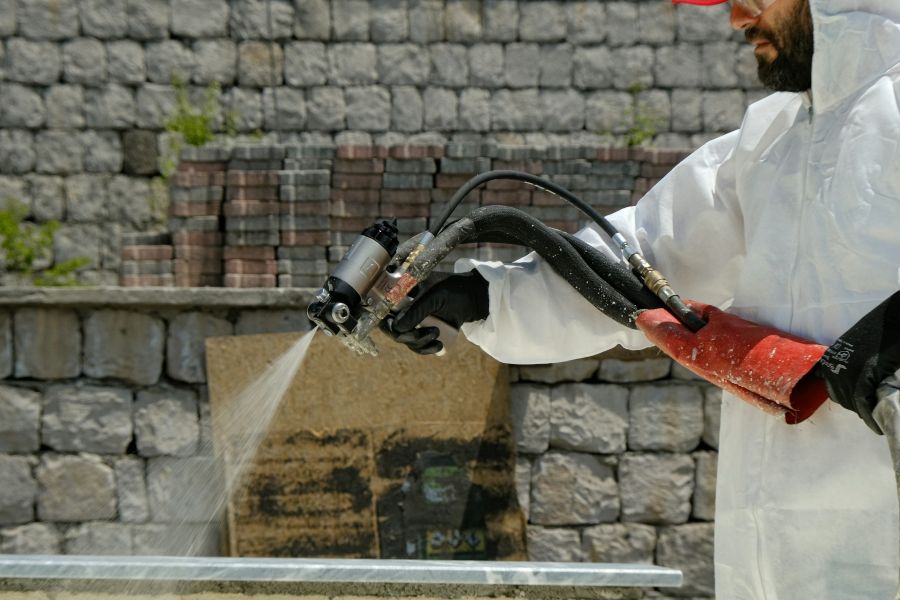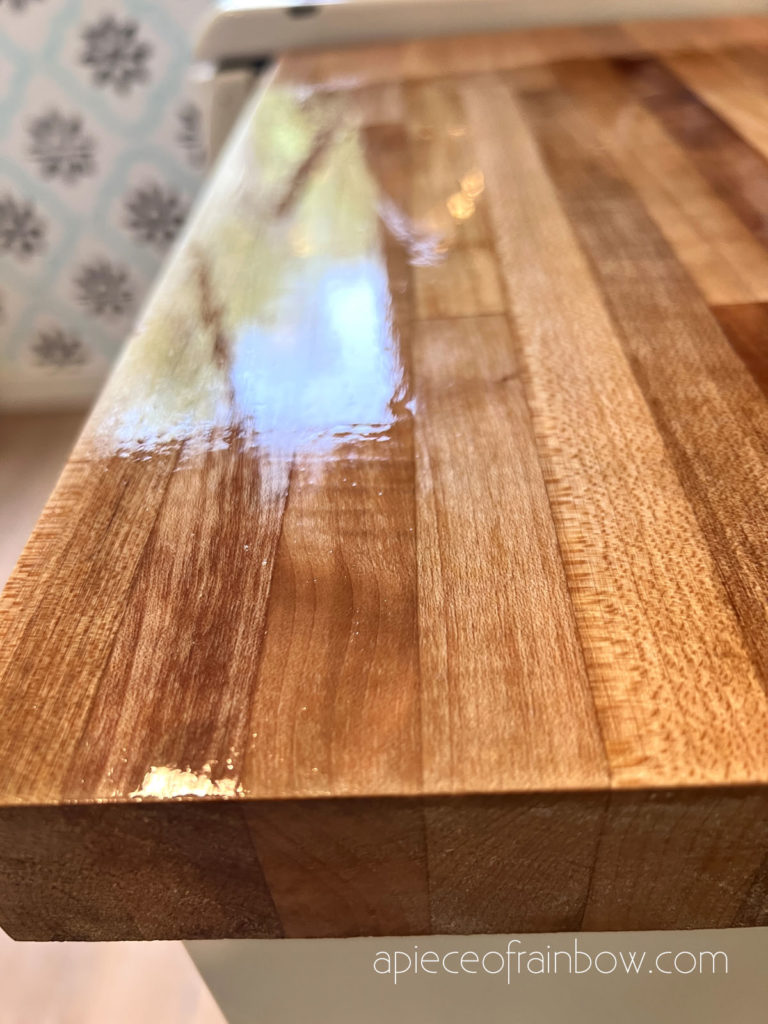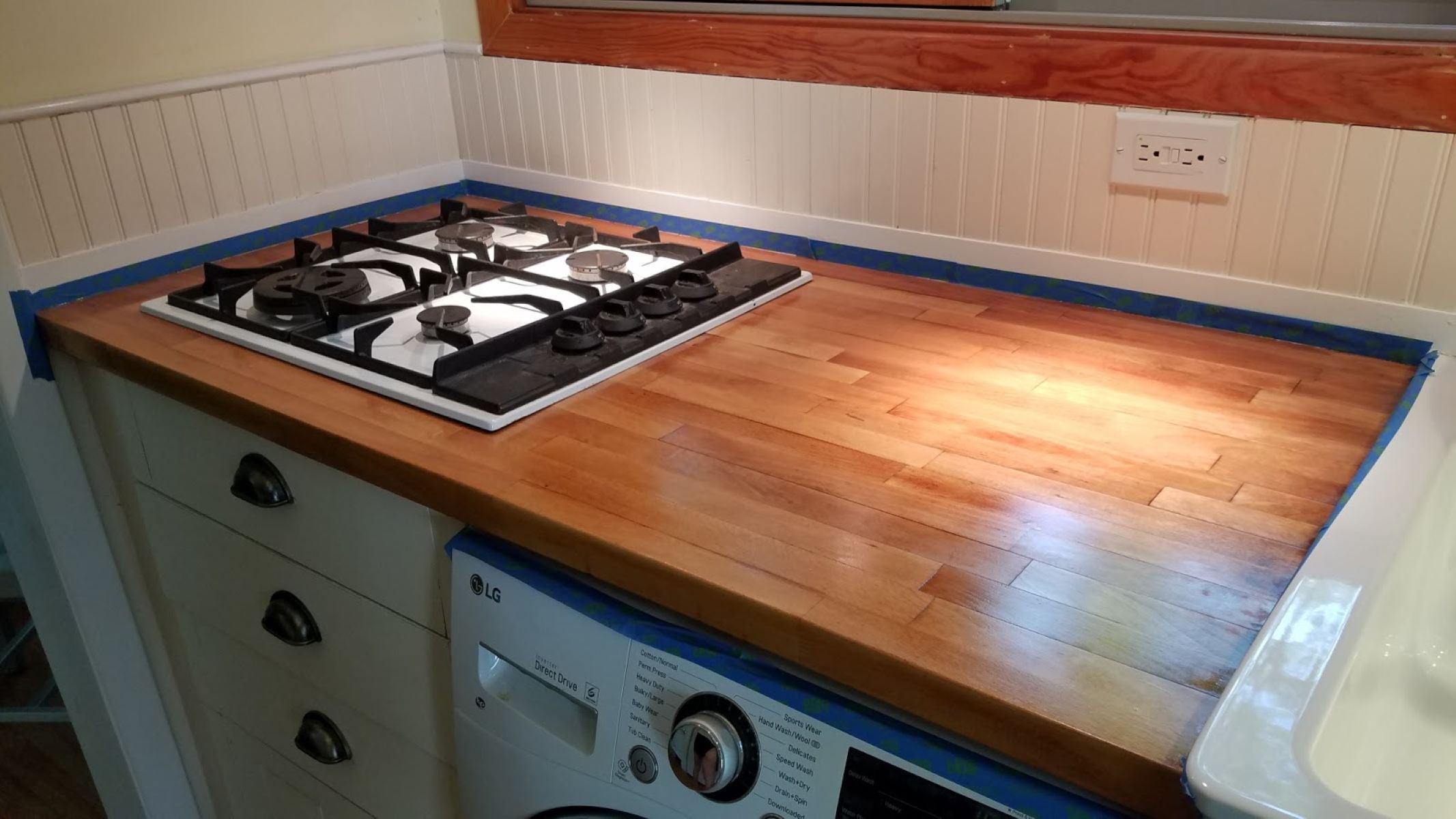
Typically, applying three coats of polyurethane is advisable for wood countertops. Each layer enhances durability and provides a smooth finish.
Wood countertops blend style and functionality in kitchens and workspaces, making their protection crucial. Polyurethane stands out as the protective sealant of choice, offering a hard-wearing finish that safeguards the wood from spills, stains, and scratches. Ensuring a well-applied polyurethane coating can significantly extend the life and beauty of your wood surfaces.
Using the right number of coats is paramount: too few may leave the wood vulnerable, while too many could create a plastic-like, overly thick finish. The key to success lies in achieving the perfect balance, which typically involves applying three well-executed coats. Between each layer, proper sanding is essential for optimal adhesion and a flawlessly smooth result. High-quality application not only secures the wood’s integrity but also brings out its natural lustre, enhancing your countertop’s aesthetic appeal.

Credit: www.apieceofrainbow.com
Introduction To Polyurethane On Wood Countertops
Discover the ideal number of polyurethane coats for durable, glossy wood countertops. Applying the proper amount ensures long-lasting protection and aesthetic appeal for your surfaces.
Wood countertops add warmth and natural beauty to any kitchen. But wood needs protection. Polyurethane offers this shield. This finish not only enhances the wood’s appearance but also extends its lifespan. Think of polyurethane as armor for your wood countertops. It works hard to keep them pristine and unharmed from daily kitchen activities.
Benefits Of Polyurethane
- Creates a durable surface that resists scratches and scuffs.
- Water resistance is greatly improved, keeping spills from damaging the wood.
- It offers a beautiful finish, either glossy or matte, that can complement your kitchen’s design.
- Maintenance is simpler, as cleaning becomes easier with this protective coating.
Factors Affecting The Number Of Coats
Distinguished by its surroundings, a wood countertop’s need for polyurethane coats varies. Consider the following:
| Factor | Impact on Coat Number |
|---|---|
| Wood Type | Denser woods may require fewer coats. |
| Countertop Use | High-use areas need more coats for extra protection. |
| Desired Finish | More coats for a richer, deeper appearance. |
| Application Method | Brushing on usually needs more coats than spraying. |
The Essence Of Sufficient Coating
Getting the right number of polyurethane coats on wood countertops is crucial. It ensures they stand the test of time.
Durability And Protection
The strength of your wood countertops lies in the protective layers. Polyurethane acts as a shield. It guards against scratches and spills. Without enough coats, wood becomes prone to damage. Most professionals recommend at least three coats. Each coat needs to dry and be lightly sanded before the next one.
Visual Appeal And Smoothness
A well-applied finish brings out wood’s natural beauty. Multiple coats of polyurethane enhance the grain. The wood’s character shines through with depth and clarity. Achieving a level surface requires uniform coverage. Aim for a smooth, streak-free finish.
Maintenance And Longevity
- Easy to clean: Adequate polyurethane makes cleaning a breeze.
- Resists water: The right amount keeps moisture out, preventing warping.
- Long-lasting: Durable protection edges out the need for frequent refinishing.
Remember, patience pays off with each layer contributing to your countertop’s lifespan.
Determining The Optimal Number Of Coats
Determining the optimal number of polyurethane coats on wood countertops is crucial. The right amount protects the surface. It also enhances the wood’s beauty. Thoughtful consideration leads to the best performance and appearance.
Type Of Polyurethane Used
The type of polyurethane you choose impacts the number of coats. Oil-based polyurethane typically requires fewer coats. This is because it’s more durable and has a thicker consistency. Water-based polyurethane, on the other hand, is thinner. It necessitates more coats for comparable protection. Let’s compare:
- Oil-based: 2-3 coats for a robust finish
- Water-based: 3-4 coats for adequate protection
Method Of Application
The application method is another key factor. Brushing on polyurethane allows for thicker layers. It may reduce the total number needed. Wiping it on produces thinner layers, suggesting more coats. Consider the following methods:
| Method | Coats Suggested |
|---|---|
| Brushing | 2-3 coats |
| Wiping | 3-5 coats |
| Spraying | 3-5 coats, with sanding between |
Wood Countertop Usage And Location
Countertop usage and location are vital to deciding on the number of coats. High-traffic areas need more durability. Kitchens require added protection from moisture. Contrast with less-used areas:
- Kitchen countertops: 3-4 coats recommended
- Bar tops: 4-5 coats for lasting durability
- Bathroom countertops: Good ventilation means 2-3 coats
- Decorative pieces: 2 coats may suffice

Credit: storables.com
Application Tips For Best Results
Welcome to the ‘Application Tips for Best Results’ section of our guide on how many coats of polyurethane to use on wood countertops. Crafting a durable and glossy finish with polyurethane isn’t just about the number of coats; it also hinges on the correct application techniques. Follow these tips to ensure a flawless finish.
Surface Preparation
Proper surface preparation is critical for adhesion and the overall durability of the finish.
- Clean the wood surface thoroughly to remove dust or grease.
- Sand the countertop with fine-grit sandpaper for a smooth base.
- Wipe away all sanding residue with a tack cloth before applying polyurethane.
Ideal Conditions For Application
Environmental factors can impact the drying time and finish quality.
| Condition | Ideal Setting |
|---|---|
| Temperature | 70-77°F (21-25°C) |
| Humidity | Bellow 50% |
| Airflow | Minimal to avoid dust settling |
Wait for the optimal conditions before applying your coats.
Techniques For Even Coats
Uniform application prevents runs and sags while ensuring a tough surface.
- Use a high-quality brush or foam applicator for controlled strokes.
- Apply thin layers rather than a few thick ones to build up the finish evenly.
- Allow adequate drying time between coats as specified on the polyurethane product label.
Keep edges as consistent as possible and sand lightly between dried coats to maintain a smooth surface.
Troubleshooting Common Issues
Applying polyurethane to wood countertops can seem simple. Yet, often, woodworkers encounter issues. Understanding how to fix these problems is key to a flawless finish. This part of the post will talk about how to handle common issues with polyurethane applications.
Dealing With Bubbles And Streaks
Bubbles and streaks can mar the perfection of your countertop’s finish. These often result from shaking the can or applying too quickly. To prevent them:
- Stir gently, don’t shake.
- Apply with slow, even strokes.
- Use a high-quality brush or applicator.
If they appear, softly sand the surface. Then, apply another thin coat. Folk wisdom suggests using a hair dryer can help pop bubbles. But, use caution to avoid scorching the wood.
When Additional Coats Are Necessary
Sometimes, a wood countertop needs more protection. This could be due to heavy use or previous wear. An extra coat of polyurethane may be the solution. Signs for this include:
- A finish that appears dull or worn
- Visibility of wood grain or texture
Wait for the previous coat to dry completely. Only then, lightly sand and wipe down. After, apply the next coat.
Repairing Imperfections Between Coats
It’s not uncommon to find imperfections after polyurethane dries. Dust particles or small indentations can emerge. For these:
- Allow the coat to dry thoroughly.
- Lightly sand the imperfection with fine-grit sandpaper.
- Clean the surface with a tack cloth to remove dust.
With the area smooth and clean, reapply a thin layer of polyurethane. This should blend the imperfection into the background.

Credit: renov8or.blogspot.com
Maintenance And Care Post-application
After applying the perfect coat of polyurethane to your wood countertops, attention turns to maintenance and care. Ensuring longevity and preserving the beautiful finish depends on good practices. This part of your polyurethane journey is crucial. Let’s dive into how you can keep your countertops in tip-top shape post-application.
Routine Cleaning And Care
Keeping your polyurethane-coated countertops clean is simple but essential. Start by:
- Daily dusting with a soft cloth.
- Avoid harsh cleaners; use mild soap and water instead.
- Wipe up spills promptly to prevent stains.
To maintain shine:
- Apply a gentle polish occasionally.
- Use a microfiber cloth for a smooth finish.
Spot Repairs And Re-coating
Even with careful maintenance, surfaces may need spot repairs. For minor scratches:
- Lightly sand the affected area.
- Apply a thin layer of polyurethane.
- Allow it to dry completely.
For a fresh look or after years of use:
- Sand the whole surface lightly.
- Apply an additional coat of polyurethane.
- Let cure as recommended.
Protecting The Finish From Damage
Prevent damage to your pristine surface:
| Do’s | Don’ts |
|---|---|
| Use trivets for hot dishes. | Place hot items directly on the countertop. |
| Cut on chopping boards. | Cut directly on the surface. |
| Place mats under appliances. | Drag items, causing scratches. |
Frequently Asked Questions On How Many Coats Of Polyurethane On Wood Countertops
Can You Put Too Many Coats Of Polyurethane On Wood?
Yes, applying too many coats of polyurethane on wood can result in a cloudy, plastic-like finish. Stick to 2-3 coats for optimal results and clarity.
Can You Use Polyurethane On Wood Countertops?
Yes, you can use polyurethane on wood countertops to protect them and enhance durability. Ensure proper application and curing for best results.
Do You Have To Do 2 Coats Of Polyurethane?
Yes, applying two coats of polyurethane typically ensures a more durable and even finish on surfaces. Allow the first coat to dry completely before adding the second for optimal results.
How Many Coats Of Polyurethane On Table Top?
Apply three coats of polyurethane on a tabletop for optimal protection and finish. Between coats, sand lightly to ensure a smooth surface.
Conclusion
Deciding on the right number of polyurethane coats for wood countertops is pivotal for durability and aesthetics. Typically, three coats strike a balance, offering protection while showcasing the wood’s natural beauty. Remember, proper application ensures best results. Keep wood countertops looking their best, one layer at a time.




















